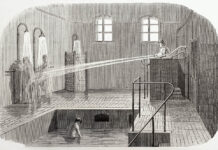Does anyone know what people who actually used mental health services were saying in Oregon before, during, and after the period of the greatest changes ever in mental health in this state and everywhere else? Was anyone listening or even asking?
This radical change took place between 1950 and 1985, when the system drastically reduced the number of people who had been in state hospitals and sent them back into their communities. That change is deinstitutionalization.
Many had high hopes for it. It has been considered a huge success by some and a total failure by others. Most would say it never fulfilled its promise. Yet the voices of people directly affected by the change have received virtually no attention in historical accounts.
This is an attempt to find those voices. This particular piece will report on the experiences of those in the hospital before deinstitutionalization, which got underway in the 1950s. It will not be a complete account of those experiences. That would be impossible. But the purpose here is to begin to share a variety of stories that tell of the experiences people in Oregon had in the state hospitals and community mental health programs. The hope is that the voices here would be of interest to other systems as they review their change from the isolation of state hospitals to the streets of community services.
Almost all published accounts of deinstitutionalization have been interested in outcomes having to do with goals like readmission, the creation of some nonhospital settings, funding, and hospital census figures. But they fail to describe what it had been like to be in the state hospitals. Nor do they speak to recovery and the role of peer support, the unmet needs for affordable housing, and the lack of attention to those things that support living in the community.
Not surprisingly, there is no insight into the ways in which medication and terms like “chronically mentally ill” interfere with recovery. In large part, medications were considered the main reason for successes in moving services from isolated, overcrowded and expenses of state hospitals to efficient and less costly community mental health centers.
What Was it Like to Be in Oregon State Hospitals?
In a series of articles published in 1957 in the Portland Journal, a minister, David Snider, wrote about his three admissions to Oregon State Hospital. The first two, in 1947 and 1954, tell of what he experienced when he was admitted on a voluntary basis.
He reported that he was subjected to assault by intoxicated ward staff members and administered ECT. He watched another patient bleed to death, and he was locked up because several staff on his ward thought he would report them for various forms of abuse, such as the trauma of being beaten by other patients when a fight broke out.

In his 1957 admission, he noted that there were major changes in the hospital culture and practices. New patients received more organized procedures but he, along with all patients, had little or no privacy. In spite of the improvements, he described how, after he injured his foot, he was denied medical care and ended up in a wheelchair. He also described how others who had been subjected to insulin injections described this treatment as “torture.”
A former patient, C. L. Brown, in an article, “A Patient’s Memories and Recent Interview of her Doctor,” described her first look at the tunnels shortly after her admission to Oregon State Hospital.
“Another patient and I ducked into the tunnels to wait out a sudden rainstorm. She asked me if I wanted to see something. When I said yes, she took me to an area where the tunnel opened up into an alcove beneath the oldest part of the hospital. She pointed to what appeared to be concrete benches, each embedded with an iron ring, and told me that patients had been chained to those rings long ago.”
The nearly two miles of tunnels beneath the elegant Kirkbride architecture of the Oregon State Hospital, located as it was in a rainy climate, provided for the dry and safe transport of food, supplies, equipment and patients between the many hospital buildings. However, due to the constant overcrowding of the hospital, they were also used for housing patients when the regular wards were full. Among the patients, there were many rumors and myths about the tunnels, including that they went all the way to the state Capitol building, which was a mile distant.
While we often hear of the dismal conditions at state hospitals, Brown told of the relative freedom of patients to walk the “beautiful grounds,” when she was hospitalized there in 1965.
“The sidewalks crisscrossing the park-like expanse, landscaped to bloom in the spring and summer, bustled with patients, student nurses, and young interns passing each other on their way to various destinations. Ground privileges were earned by patients. In return for devoting a few hours a day to an Industrial Therapy (IT) assignment, patients were rewarded with a ‘number 2 card,’ which allowed them to come and go from the buildings at will.”
The conventional story of deinstitutionalization tells of how the introduction of antipsychotics in the 1950s enabled deinstitutionalization and were of great benefit to the patients. In her account of her hospitalization, Brown described antipsychotics in a very different way. She wrote:
“Sometimes, patients were given an intramuscular injection of the drug in addition to their usual regimen. I was the recipient of such painful shots in the gluteus maximus after running away or becoming upset. On a couple of occasions, young women who refused to willingly accept the shot were taken to the floor and given the injection in front of other patients. Thus, some of us believed that the drugs were used as punishment or as a means to control a person.
“The increased dosage from a shot often led to noticeable side effects, one being an almost unbearable restlessness in the legs. I found that I needed to walk incessantly to diminish the feeling. At times, only stamping my foot on the ground helped. Some referred to this as the Stelazine Stomp. Another side effect caused muscle spasms that pulled my head toward one shoulder so that I walked bent over to one side. People sometimes developed a constriction of their mobility referred to as the Thorazine Shuffle.”
The Superintendent’s View
In 1955, Dr. Dean Brooks was named superintendent of Oregon State Hospital, and the pictures here tell what it was like being a patient there at that time. After returning from a visit from a state hospital on the East Coast, where he had seen a number of abuses, he wondered whether these types of abuses were being experienced at his hospital. He began doing night rounds.
Having seen that some patients were going barefoot at Oregon State Hospital, he began what he called a “massive fact-finding operation.” He set up study groups that brought together staff, patients, community members, high-level state administrators from the Secretary of State’s office, and even legislators. He directed the groups to look at things from the standpoint of the patients, not “the purchasing agent,” with the goal of “prevention of the dehumanization of people in our hospital.” Brooks’ mantra was to “find fact, not fault!”
The groups reviewed hospital practices like clothing, dental hygiene, bathing, toileting, grooming, sleeping, recreation, eating, housekeeping, patients’ money, personal possessions, maintenance, aesthetics, living space, and admission and discharge routines. Each study group came up with findings and made recommendations for change.
Brooks also started his own superintendent’s committee composed of patients. From this committee, he learned more about what the patients in the hospital experienced. One person told him that there was no place to hang their towels, but that complaint left unsaid a bigger problem, which was that people had to use towels that were either soiled or had been used by someone else. This had been the experience in the entire hospital for more than two decades.
In addition, some women were forced to take baths whether needed or not, a form of what Brooks called “mortification,” which he may have learned about during his enrollment in the Navy during World War II. Women told of feeling humiliated, embarrassed, and disrespected. They also felt demeaned and ashamed by having to wear ill-fitting and unfashionable state-issued clothes.
On some wards, garbage was scraped from table into bags while meals were still being eaten. The food was often cold. As a result, mealtimes were some of the least pleasant times of the day, rather than time for enjoying food and socializing. On one ward some men had night clothes, others did not. The blankets were often so shrunken so that if you wanted to stay warm at night, you would sleep in your daytime clothing.
Brooks pointed out many of these elements were considered “treatment” rather than being recognized as dehumanizing, a classic form of institutional anosognosia (as I described in the previous account in this series, “Everything About Us Without Us”).
While there were many of the improvements in the lives of the patients after Brooks was appointed superintendent in 1955, many problems remained. The hospital remained crowded (37% over capacity), understaffed, and underfunded. Two of the “therapeutic” practices that Dr. Brooks ended were lobotomies and insulin shock treatment. But as Brooks confessed later in life, the hospital remained far from a perfect place.
Finally, little has been writing about the patients whose problem was related to alcohol abuse. In 1955, for instance, 20% of people admitted (or almost 600 of 2,890 admissions) suffered alcohol withdrawal reactions, with severe symptoms like hallucinations, shaking and confusions. They were then subjected to a crude use of Antabuse after their withdrawal.
Men outnumbered women 7 to 1 in Oregon State Hospital. There is almost no data available that tells where these patients went after being discharged, or how they were treated. What is known is many were readmitted after a time in the community.
While abuses were many, and conditions often abysmal, patient accounts from that time nevertheless often told of finding a camaraderie by being with other patients. Here is one such reflection, from an unnamed patient:
“In the ward I was in, it was refreshing. Most of the staff weren’t much chop, but the other patients were amazing. When staff weren’t around, we joked about various suicide methods regularly, and about how much more the psychiatrists needed mental health help than we did. We discussed how we all (as patients) helped each other far more than any medical professionals did. I laughed with these wonderful people more than I ever have in my life. We joked about suicide watch, and how easy it would be to get around that. We discussed in detail exactly the methods we could employ. It gave us comfort to know that others had the same.”
Ward 81 Project
Ward 81 Voices, a book published in 1979, provides a compelling photographic record of conditions at Oregon State Hospital. Brooks granted a seasoned photographer, Mary Ellen Mark, permission to spend more than a month on the ward, with the thought that she could gain the trust of the women and make a photographic record of their lives. A psychologist, Karen Folger Jacobs, accompanied Mark.
They were warned against living on the unit, a warning they disregarded. It was a maximum-security unit, and they were told that it housed the most disturbed women in the hospital. One woman had murdered her husband, and the others were all confined there for past instances of violence of one kind or another. Most were considered to have lifelong psychotic diseases. Yet, Mark and Jacobs spent over a month on the ward with the women.
The result was a compelling set of pictures, a one-of-a-kind understanding of what life for the women was in a forced “treatment” setting. What did they discover? First and foremost, as one reviewer wrote, “Mark’s photographs suggest that there was a thin line between the patients confined at OSH and the people outside the walls.” One disturbing finding was that the women’s quarters were strikingly different from the nearby men’s ward—they were in a substandard unit without personalized care and psychiatrists who showed little interest in who they were. This aspect of Ward 81 Voices helped stimulate policy changes after Jacob testified before the US President’s Commission on Mental Health shortly after publication of the book.
Another was that few of the women were ever allowed outside. Some were locked or strapped in their beds. When they looked out their windows, they saw wire barriers.
Many became quite open with Mark and Jacobs. On the first day they were there, one said she just want to be loved and supported. One expressed a desire for a motorcycle gang to take over the hospital and get rid of all the aides. Some said they just wanted friends and paper dolls. Some worried that everything they said was considered crazy. Some wanted to get dressed up and look pretty.
And they worried too they would never get out, and dreamed what they would do if they did get out. And they told Mark and Jacobs of how they would see their “friends” on the ward get ECT and come back babbling and peeing on themselves. Other patients came back so destroyed from treatment that they figured they had been lobotomized. It was like being in prison, they said. They wanted dignity, and to be noticed and treated with warmth. They wanted hugs. They wanted to have contact with boyfriends.
Why weren’t these conditions, and the voices of the Ward 81 patients, known before the book was published? While it may not be a complete explanation, the hospital during all this time was crowded beyond its physical capacity, underfunded and with hundreds of employees to manage. The patient population peaked at 3,541 in 1957, meaning the hospital housed a population the equivalent of a small town.
Such are the accounts of conditions at Oregon State Hospital in the 1950s, and to an extent, in the next decade as well. The patient voices do tell of poor conditions, abuses, loneliness, and despair, and yet, they also tell of some patients who found a comforting companionship in the hospital, and in the character of Dean Brooks, a superintendent who sought to address the abuses after he arrived in 1955.
My next post in this series will tell about the deinstitutionalization process in Oregon.















While “deinstitutionalization” can be seen as a “great change” in the mental health system of the last century, I see it as merely a move to increase the number of patients and the amount of money flowing into the pockets of the psychiatrists.
The truth is (as far as I know) that the mental hospitals were not successful in making people well, and that neither are the community “mental health” centers. This is because, while Psychiatry had discovered various ways to make money, it had not discovered how to cure people, and in fact, this was not even necessarily in their financial interest.
Conditions in most state hospitals were atrocious, and the whole reform movement, some say led by Kesey’s “One Flew Over the Cuckoo’s Nest” (1962), was in part a reaction to those atrocities. Today we have the “homeless” problem, in many ways equally atrocious. And the fact is, we still don’t know how to make people better (or help people become what they would like to be).
It is not like there are no workable suggestions out there. But they are being shot down (or so it seems) by Psychiatry. Those of us who can see this know we have two challenges ahead: 1) To expose Psychiatry for the fraud that it is – including but not exclusively concerning their atrocities; and 2) Adapting the various workable alternative practices for widespread public use. If we don’t provide people with a workable alternative, they will only fall back on Psychiatry for “answers.” And we know from experience that they won’t be good answers.
Report comment
Having actually visited and worked in both the developmentally disabled and mental health state institutions as the system was changing I had in a small way a Birds Eye view. My first encounter was a tour yes a tour and our high school teacher probably had no idea that tours at one time on site charged tours with Bedlam and other places were how they were financed. A literal sideshow concept. The hospital was on the verge of ruin and had at one time been on of the moral treatment system scale and was a small village with at one time its own post office a the library but falling apart. I went to a college field placement at another state institution that had been a mental health hospital and then turned into holding developmentally disabled folks until allowed or found space for a residential placement. Lice was a problem and again it was falling apart .
And the separation of dx was arbitrary one saw both at each place.
The other aspect not often talked about was the families how they had family members committed. Many times with children doctors told family forget you ever had that child. For emotional mental health issues if one looks at the commitment papers anyone could be sent in and one can see the short life spans as death certificates are part of the old probate court archived files.
There was no real plan. Dr Sydney Wolf was a big voice back in the day. Federal monies were promised but much did not arrive. Some states would have levies counties as well. Some had both MH/ DD work others separate and stigma all around for the mental health levys. A culture of silence was always there sometimes continues to this day though MIA brought a lot out into the open which I will be forever grateful. Some families felt guilty ashamed and how can one parent when one never had only hand to mouth childhoods or extensive family loss? When one looks into individual histories lots of hard hard happenstance’s. For the developmentally disabled many hidden away. Hard hard times with few national, state, or local supports long term. Lots of initiatives but always the pull for less which affects even staff members at agencies and other systems.
We do not yet have a caring focus or system in place. It is obvious that if we don’t change then the entire system will collapse because of not caring and lack of community supports except the very rich and even that with the current article on the troubled teen industry even well off people in crisis many times do not get the support they need.
This history is so vital to keep the memory what was – what is needed now. Oral histories and archives and sites like this primary steps to a perhaps maybe better for all.
Report comment
Dear Mr.Nikkel, Thanks for posting your account of patients at Oregon State Hospital had to say about conditions there prior to deinstitutionalization. I was a patient at The Pontiac State Hospital in Pontiac, Michigan, in 1960 at the age of 16. I’ve posted my own account of what it was like for me on MIA (“State Hospital Memories: More of My Story,” and “Committed at 16: State Hospital Memories”). Horrifying as these individual accounts are, they were most frequently disregarded by Legislatures, Departments of Mental Health, Governors and others responsible for the poor conditions. It was easy enough for the system to just write them off as the product of “sick” minds. I remember reading that at Pontiac they just threw patient complaints in the wastebasket without investigating them. To verify them, of course, would take an independent investigation. I was lucky enough to find accounts of life at Pontiac in The Detroit Free Press, one of Michigan’s most widely circulated newspapers, which I included in my second article in MIA. Pontiac lost its accreditation in 1979 after the American Medical Association’s Joint Commission on Accreditation of Hospitals (JCAH) visited. The problems they found included lack of professionally trained staff, lack of treatment resources, and allowing patients to be idle most of the time. My own account likewise noted these conditions, and, along with physical abuse and shock treatment, were the reasons I urgently wanted to get out of there in 1960. To further verify patient accounts, I think what is needed is a follow-up of those patients still living. I have asked the Michigan Department of Mental Health and the Mental Health Committee of the Michigan House of Representatives and others to undertake such a study, but received no responses back. This is truly an unfortunate situation. Perhaps you know how the conditions of institutions prior to deinstitutionalization can be further documented. It would be very much welcomed by former patients such as myself and their families, help set the history of mental health treatment straight, and draw attention to the current problems that the mentally ill are having to obtaining adequate treatment and some of the reasons they are being denied.
Report comment